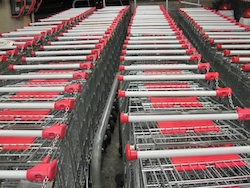 Retail parks found in orbit around our cities and towns have long been criticised for their negative impact on the environment, helping to promote a car-based, non-sustainable culture. They are also fighting a battle with shopping centres to become leisure destinations in their own right. However, a number of forward thinking owners are discovering that being sustainable can make good business sense, helping to drive visitor footfall and dwell time as well as generate revenue. So, what are owners doing to make their retail parks sustainable and attractive places?
Retail parks found in orbit around our cities and towns have long been criticised for their negative impact on the environment, helping to promote a car-based, non-sustainable culture. They are also fighting a battle with shopping centres to become leisure destinations in their own right. However, a number of forward thinking owners are discovering that being sustainable can make good business sense, helping to drive visitor footfall and dwell time as well as generate revenue. So, what are owners doing to make their retail parks sustainable and attractive places?
Although the raison d’etre of retail parks is to provide easy access by car, much can be done to improve their green transport credentials. The benefits of this have also been recognised by retail park owners and tenants, as green transport schemes help to reduce traffic congestion, as well as enable customers without a car to get to the retail park. The first step towards reducing transport environmental impact is to develop a green travel plan. To guide the plan a travel survey of tenant employees and customers is recommended. This will help identify transport patterns and where improvements could be made.
Retail park owners can implement a variety of green transport measures, such as to promote cycling by introducing cycle racks and covered, secure cycle parking for employees and customers. Car sharing schemes among tenant employees should also be encouraged. It is also important to work with local authorities and transport providers to examine ways to improve the retail park’s public transport connections. Additionally, it is worth considering providing recharging points for electric or plug-in hybrid vehicles.
One of the main criticisms levelled at retail parks is that many are vast soulless tracks of tarmac. However, they can be transformed into appealing and attractive places for people. Pleasant green spaces have a positive impact on people’s perception of a place and boosting biodiversity is one way to achieve this. Planting plans with wildlife corridors linking habitats enable wildlife to thrive. Less rigorous cutting regimes combined with seeding meadows with a variety of wildflowers and grasses is particularly becoming popular. The use of a variety of broadleaved tree and shrub species also helps improve biodiversity.
Where appropriate, green walls – walls planted with climbing plants and the use of mesh for grasses and other plants, can help boost biodiversity. Similarly, green roofs, which have the added advantage of slowing drainage run-off and providing insulation, should also be considered.
A biodiversity improvement programme can be integrated into a sustainable drainage plan to help avoid flooding. Soft landscaping, holding ponds and rain garden areas help to reduce run-off, as well as provide an attractive amenity.
Improving biodiversity also provides an opportunity to engage with local communities. This can be achieved by, for example, managing ecologically a pond on site through a local environmental group or working with local schools to adopt the pond. The Crown Estate has been very active in this area, liaising with local schools through the ‘Underneath the big green leaf’ initiative.
To reduce carbon emissions there are two approaches: reducing energy consumption through increasing efficiency and introducing renewable energy generating technology. Site car park and street lighting is one area where owners can cut energy consumption. Conducting a lighting audit can reveal where efficiencies can be made through better siting, directing light to where it is required and via technical improvements such as LEDs.
However, to make further energy saving gains it is essential for owners to work with tenants. Sharing best practice is one way to help tenants save energy. For example, by including information on energy efficiency technology that is eligible for Enhanced Capital Allowances in the fit out guide provided for tenants. Working with tenants to monitor energy consumption will provide important information to help implement energy saving measures. Areas to focus on include insulation and the heating, ventilation and air-conditioning systems. To help foster a collaborative approach to improving sustainability, green leases, leases with environmental clauses, can be introduced when renewing lease agreements.
Water is also a valuable resource. The tenants will be the main users of water and it will be under their control; however, landlords can offer guidance on water saving measures. Drought resistant planting that relies on natural rainfall will obviously reduce water demand. As part of the sustainable drainage system (SuDS), rainwater harvesting from roofs and hardstand can be done to provide water for irrigation.
In the case of generating renewable energy, roof-mounted photovoltaic panels present a great opportunity. The cost of photovoltaic technology has dropped during the past few years and despite a reduction in the feed-in tariff, the technology has become more viable. However, roof structural integrity and, if necessary, reinforcement must be taken into account, although panels have become lighter.
Recycling and reducing the amount of waste that goes to landfill has become a major issue. Providing bins for recycling and getting tenants to work together with a centralised waste management system can boost recycling rates and reduce waste that goes to landfill. Furthermore, helping tenants to club together in arranging waste management contracts rather than having individual contracts can save money.
Providing a pleasant natural environment is one aspect of place-making. Another is to encourage people to stay by providing facilities such as cafés and restaurants that increase dwell time. Associated with this is optimising asset use by offering pop-ups or temporary stores for local businesses in vacant or soon to be refurbished units. This also provides an opportunity to improve links with local communities.
In a nutshell, owners and tenants taking a collaborative approach, which also encompasses local communities and public bodies, can make great strides towards more sustainable retail parks. Furthermore, as well as saving energy costs at the same time they can make retail parks attractive destinations for people to spend their leisure time, benefitting owners and tenants.
About the author
Mat Lown is a Chartered Building Surveyor, Partner and Head of Sustainability at construction and property consultancy, Tuffin Ferraby Taylor. 
Have you any commercial property events you'd like to tell us about? It could be networking, exhibitions, seminars, industry lunches or sporting fixtures. We will list them for free. Just email newsdesk@propnews.co.uk with the following details: Event name, date, time, venue, cost, booking info and a brief description of the event.
To list your property job vacancies on Property News. Email: richenda@propnews.co.uk.